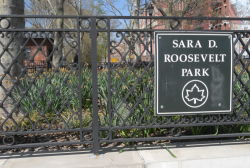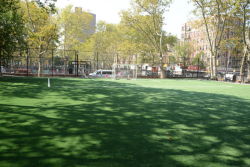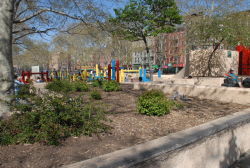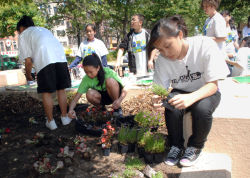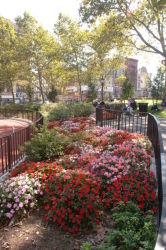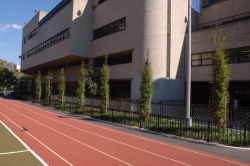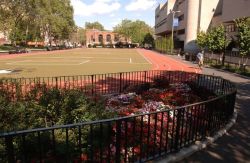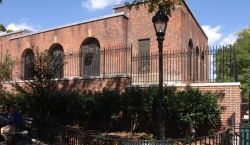Sara D. Roosevelt Park
The Daily Plant : Tuesday, September 14, 2004
THE GROUNDBREAKING SCOOP
Running Circles around the Competition
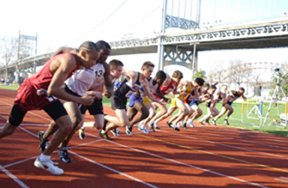
The fastest man on earth, Justin Gatlin, said the track in Athens, on which he won the gold medal in the 100-meter dash last month, made him feel like he was "running on air." The New York City Department of Parks & Recreation designs, builds and offers the public running tracks made out of the same material (sometimes even higher caliber material) as those on which Olympic runners compete.
"The upgrade and enhancement of Parks & Recreation track & field facilities is a logical step in making this type of athletic activity more accessible for New York City’s young athletes," said Deputy Commissioner for Public Programs Kevin Jeffrey. "These regional venues reduce travel time for kids and allow for higher-level competitions to be held locally. For example, the First Annual Mayor’s Cup meet was held this past April at the new track in Astoria Park, Queens. Nearly 1,500 young athletes from the City’s public, independent and parochial schools competed."
Outdoors in parks and indoors in recreation centers throughout the city, the Parks & Recreation Capital Projects division is developing elliptical tracks made from prefabricated rubber panels. These panels are manufactured in the controlled environment of a factory, eliminating variables like erratic temperatures that can effect the installation process of a pour-in-place (on-site) rubber crumb system often used to coat tracks. Prefabricated materials cost more, but they guarantee quality, longevity and resiliency. They also require less maintenance than the once popular cinder-surfaced tracks.
To construct these tracks, natural rubber is mixed with pigment and produced in custom-made sheets. Once transported to the site, the sections are laid down like a carpet over a carefully prepared and graded sub-base. Proliferating across the city, these new tracks are smooth and brightly colored with demarcated lanes. The almost imperceptibly bouncy surface minimizes the adverse effects that pounding pavement might otherwise have upon users and puts a slight spring in every runner’s step.
Deputy Team Leader for Bronx Capital Projects Andrew Penzi was the Landscape Architect who designed one such track in Pelham Bay Park. The regulation 400-meter track, just one component of a new track & field facility for New York City’s largest park, replaces a worn out pour-in-place system. The track will wrap around a new synthetic turf football field. Long jump, high jump, pole vault, discus and shot-put facilities are also being built in the vicinity. Construction, which began in February on this $2,505,000 project, is expected to be completed by the end of this month. Funds were allocated by Mayor Michael R. Bloomberg, Council Member Madeline Provenzano, and a Dormitory Authority Grant.
Also in the Bronx and set to open by the end of September, a shorter course is under construction at Bathgate Park. The inner oval area bounded by the track is being surfaced in the same rubber material as the track itself. Here, under the careful supervision of Resident Engineer Ahamad Baksh, different colored rubber pieces are being cut and installed to form a map of the earth.
Ground in Brooklyn is about to be broken for a new track at Linden Park, and Brooklyn Team Landscape Architect Marcha Johnson is in the process of designing a 400-meter track to replace the existing cinder one at Kaiser Park. At Victory Field in Forest Park, Queens, where the Mayor just cut the ribbon on a brand new synthetic turf baseball field, construction on a new little league field contained inside a track has already begun, and a track for Keith Williams Park is in design. An indoor track, currently under construction at the East 54th Street Recreation Center in Manhattan, will loop around on a gallery above the perimeter of a basketball court below. On the Lower East Side, a new rubber track and synthetic turf field are under construction at Sara D. Roosevelt Park.
Icahn Stadium on Randall’s Island, already in construction, will house the only Class 1 IAAF certified track in the United States. Designed with an asphalt and gravel sub-surface for superior drainage, the level of the track will fluctuate by less than an eighth of an inch over any ten feet of track. Meeting and superceding even-gradation and other requirements qualifies the venue for hosting international competitions, rendering it an eligible candidate to hold the next Summer Olympic trials in 2008. The new stadium will have seating for up to 10,000 spectators, a roof, light towers for night usage, a regulation-size soccer field, locker rooms able to accommodate up to a thousand visiting athletes and training and treatment rooms.
Icahn Stadium will attract world-class events, while also providing a key resource to local communities and schools. The $45 million project is funded by $22.6 million in public funds and the rest by private donations raised by the Randall’s Island Sports Foundation and Parks & Recreation, including a $10 million gift from Carl Icahn. It is scheduled to open in spring 2005.
Written by Adrian Sas
QUOTATION FOR THE DAY
"Life is often compared to a marathon, but I think it is more like being a sprinter; long stretches of hard work punctuated by brief moments in which we
are given the opportunity to perform at our best."
Michael Johnson
(b. 1967)
Check out your park's Vital Signs
Clean & Safe
Green & Resilient
Empowered & Engaged Users
Share your feedback or learn more about how this park is part of a
Vital Park System

